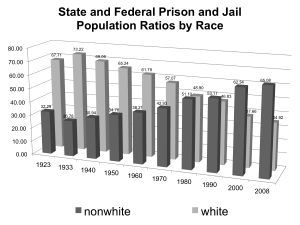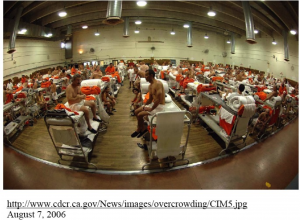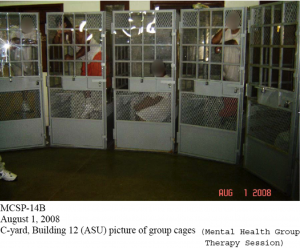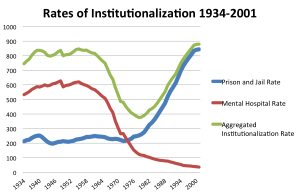By Bernard E. Harcourt
I am simply trying to see, to reveal, and to transform into legible discourse, legible to all, that which may be unbearable for the most disadvantaged classes in our current system of justice. — Michel Foucault, 1971, Dits & écrits II, # 95, 205-209, p. 206
The Foucault 3/13 seminar raised an important methodological question regarding how to take account of the singularity of imprisonment, and proposed, as one answer, moving back and forth between the specificity of the prison and the threads that weave through power relations.
Let me propose here, from this perspective, a two-pronged analysis of our present condition of racialized, massive over-incarceration in the United States: mass incarceration must be understood, simultaneously, as a unique phenomenon—uniquely dehumanizing, and the product of a unique set of political and social circumstances in the United States over the past 40 years—but also, at the same time, as another episode of mass injustice in this country. To understand it properly, it must be placed both within the domain of the exceptional and in the realm of the repetitive.
It is exceptional in its specific manifestation and antecedents.  The racial discrimination is staggering: the cumulative, consistent, continual racial disproportionality over the course of the 20th century, as evidenced here by prison admission rates by race.
The racial discrimination is staggering: the cumulative, consistent, continual racial disproportionality over the course of the 20th century, as evidenced here by prison admission rates by race.
The extremes of overcrowding, on the one hand, and at the other end, of solitary confinement.  The inhuman conditions, for those who are suffering for mental illness, of the suicide watch cell, of the acute suicide watch cell, of the human cage to be transported to psychiatric treatment, of therapy session, of group therapy. The conditions in which we put our fellow human beings today are, simply, uniquely inhuman.
The inhuman conditions, for those who are suffering for mental illness, of the suicide watch cell, of the acute suicide watch cell, of the human cage to be transported to psychiatric treatment, of therapy session, of group therapy. The conditions in which we put our fellow human beings today are, simply, uniquely inhuman.
It is also unique in terms of its antecedents. A study in the American Journal of Sociology by Michael Campbell and Heather Schoenfeld meticulously dissects the micro- and macro-level interactions between political initiatives, sentencing reforms, special interest lobbying, that occurred at the intersection of the political and penal fields to produce three periods corresponding to our new penal order: first, destabilization through 1975, second, the contestation of high-crime politics through 1992, then solidification of the new penal order well into the 21st century. This is a unique trajectory and result.
At the same time, it is vitally important to step back and place mass incarceration within a larger arc of recurring forms of excessive punishment in this country, to understand that these specific reforms—three-strikes laws, mandatory arrest policies, police profiling—fit within a larger framework of governance, of views about the proper role of the state. The repetition and recurrence must be interrogated in relationship to the peculiar institutions of slavery, Jim Crow, and the ghetto—as Loic Wacquant and Michele Alexander have shown—but also more recently to the massive institutionalization of mental patients in asylums in the 1930s, 40s and 50s, as well as the mass internment of Japanese-Americans during the Second World War. These phenomena cannot be properly understood separately.
We need to take a dual perspective—somewhat like a pair of bifocal glasses that can help us both see afar but read up close, that can help us focus both on the longue durée and on the unique present—in order to explore not only the micro-political forces that pushed toward mass incarceration, but also what prevented us this time, as well as times past, to resist more effectively. It is crucial to look back in order to turn inward, to search within ourselves, to explore why we did not resist more or better the crack sentencing and the Rockefeller laws, why so many of these policies were implemented by liberals, by Democrats, what it is about security and policing that insulates them from our critical, liberal, or progressive values.
The questions are not just rhetorical: I believe there is actually a perverse connection which is directly tied to what can be called the paradox of neoliberal penality. In this country, the recent cycle of excessive punishment has been made possible—it has been made tolerable—in large part because of our paradoxical belief in the incompetence of government in economic and social affairs coupled with our strange faith in the state when it comes to security, policing, and punishing.
I will explore this issue here by focusing on repetition and difference: first, on the repetitions of mass institutionalization; and second, on the unique neoliberal economy of mass incarceration.
(1) Repetition: A Prior Episode of Mass Institutionalization
First, the rate at which this country institutionalized people in asylums in the 1930s, 40s, and 50s was staggering, and somehow hidden from our view—practically till today. It took place in all kinds of facilities: institutions for “mental defectives,” for “epileptics,” public and private institutions for “the mentally retarded,” psychopathic hospitals, psychiatric wards at VA hospitals, state, county and city hospitals, public and private. The conditions in many of these institutions were appalling. Frederick Wiseman’s 1967 documentary, Titicut Follies, would expose those practices—and would be censured. But eventually, we began to see inside.
Here too, the phenomenon was unique. Very different, demographically. In the 1960s, about half of the institutionalized patients were women, whereas throughout the twentieth century, about 95% of the incarcerated were men. The mental hospital populations were far more white and older. In 1923, for instance, 92.2% of asylum patients were white and only 7.6% percent were African American, in sharp contrast to prisons today which are over 40% African American and 20% Hispanic.
And it occurred during a very different time of welfarism, of provident government, of 5-year plans—mostly as a result of WWII centralized planning and New Deal responses to the Depression. What we would witness, across the states was a massive build-up of asylums and mental patients, disproportionately targeting marginalized women and, in the Southern states, African-Americans.
It represented a different form of excessive punishment shaped by distinct sets of ideas: faith in the state as protector; a rehabilitative model associated with the welfare state. As Frances Fox Piven and Richard Cloward show in their classic book Regulating the Poor, the “rise of welfarism and the gradual turn to prudentialism” represented, at its worst, a distinct kind of punitiveness. Its demise took the form of massive deinstitutionalization, with all its problems of trans-institutionalization and racial discrimination, and collapse of welfarism. What is remarkable for our purposes, though, is that it almost equaled in size mass incarceration today, yet received little attention at the time.
(b) Difference: The political economy of the prison
The turn to law-and-order after the turmoil of the 1960s and the backlash against the Civil Rights movement fit within a unique neoliberal paradigm—of faith in deregulated markets, accompanied by new theories of human capital that would result in the radical disinvestment in certain minority populations and reinvestment in other communities, namely middle-class prison labor. An entirely different set of beliefs about the state, about governing, would mark the shift from the asylum to the prison. It involved a resurgence of economic liberalism and with it, the paradoxical idea that government is incompetent when it comes to economics, but has only one function, and that is policing and punishing.
Although neoliberal penality is unique, here too there may be repetition and difference: repetition in the linkage between economic liberalism and the police state, difference in the newer theorization surrounding human capital.
As I suggested in an earlier post for Foucault 3/13, there has been a lengthy historical link between economic liberalism and the police state. It can be shown by tracing, first, the diachronic evolution of two historical ideas—that of the free market on the one hand and how it developed from notions of natural orderliness from the 18th Century physiocrats onward and of a police state on the other—and, second, the synchronic linkage at each of the historical stages of these two necessarily imbricated notions.
Today, the notion of freedom of markets and deregulation is inextricably linked to trust in our government to provide security. The fact is that today, the vast majority in this country believe that the state is basically incompetent at managing an economy and cannot be entrusted with much, except policing. Over 70 percent of respondents in the United States agree that “The free enterprise system and free market economy is the best system on which to base the future of the world.” And there is a symbiotic relationship between free, efficient, competitive markets and the penal law. This paradoxical juxtaposition of economic liberalism and the Leviathan police state has facilitated punitive excess—not just in the last 40 years, during the period of neoliberalism, but also during the early 19th century and the birth of the penitentiary in the Jacksonian era, during a period historians now call “the Market Revolution.”
At the same time, new notions of human capital are important here, and are different: they facilitate a politics at home that treats people as human capital some of whom are worth the investment, and others not. It gives way to governmental policies that differentiate between good and bad human investments. And politics soon becomes the art of discerning in whom to invest. (We will surely return to this in our seminar on The Birth of Biopolitics).
On the one hand, hyperincarceration reflects a complete financial disinvestment in the young African-American and Hispanic men who make up the jail and prison population. There is no investment in their education, nor in their housing, nor in their family situations, nor in their health. Public housing in the United States is dilapidated and abandoned—left to ruin. Nowhere is this more evident than in Chicago. There is no safety net for the unemployed or those suffering from mental illness: Downtown Los Angeles is a tragic illustration, described, accurately, as a “wretched” area where thousands of destitute, mentally ill, and drug-dependent human beings sleep on the sidewalks, pitch tents, make shelters and encampments out of discarded cardboard boxes, urinate and defecate in the street, wander about, trolling shopping carts overflowing with all their earthly possessions.
On the other hand, there is significant investment in the communities that welcome and derive financial returns from prisons and jails. The states invest approximately $47 billion per year in this economy, including wages for guard labor to then invest in their families and the service industries that cater to the prisons. These investments create micro-economies that depend entirely on the prisons. As a result, the counties that are home to prisons resist ferociously when local and state governments threaten them with the closure of their capital investment—the prison.
And sadly, there is evidence that this investment strategy “succeeds”—or at least, helps validate the American neoliberal theory of economic prosperity. As Bruce Western’s work shows, the economic growth of the 1990s is a fiction only made possible by excluding from our calculations everyone in prison. The idea of economic improvement, especially for African-Americans, during the 1990s depended on prison growth. It was an artifact of exclusion.
In sum, while we use the close-up part of our bifocals to isolate the individual variables that produce three-strikes, mandatory minimums, and ultimately mass incarceration, we also need to account, from afar, what makes tolerable the massive detention of predominantly young African-American men, as well as L.A.’s Skid Row or the destruction of Chicago’s public housing, as well as previous episodes of massive injustice going back to slavery.
In the end, the answers to these questions turn in part on the moralizations that make things tolerable. Recently, it has been the demonization of the inner-city youths through the war on crime, conservative law-and-order politics, notions of the criminal as social enemy, aka the “super predator,” and an embrace of carceral solutions. The demonization of black and Hispanic young men cannot be quantified—in contrast, say, to crime rates—but it has contributed importantly to our apparent inability to resist the tidal wave that hit America starting in the 1970s.
There has been a real struggle, or as Foucault would suggest in these 1973 lectures a “civil war,” that has produced the notion of the criminal as social enemy. The demonizations, the moralizations are what has made tolerable to so many what should have been and is intolerable today. In the end, to understand how we got here, we need to focus on both the specificity of mass incarceration and the commonalities of forms of injustice going all the way back to slavery—on both the difference and the repetition.

